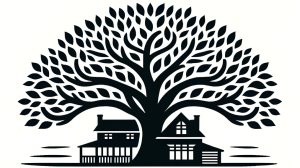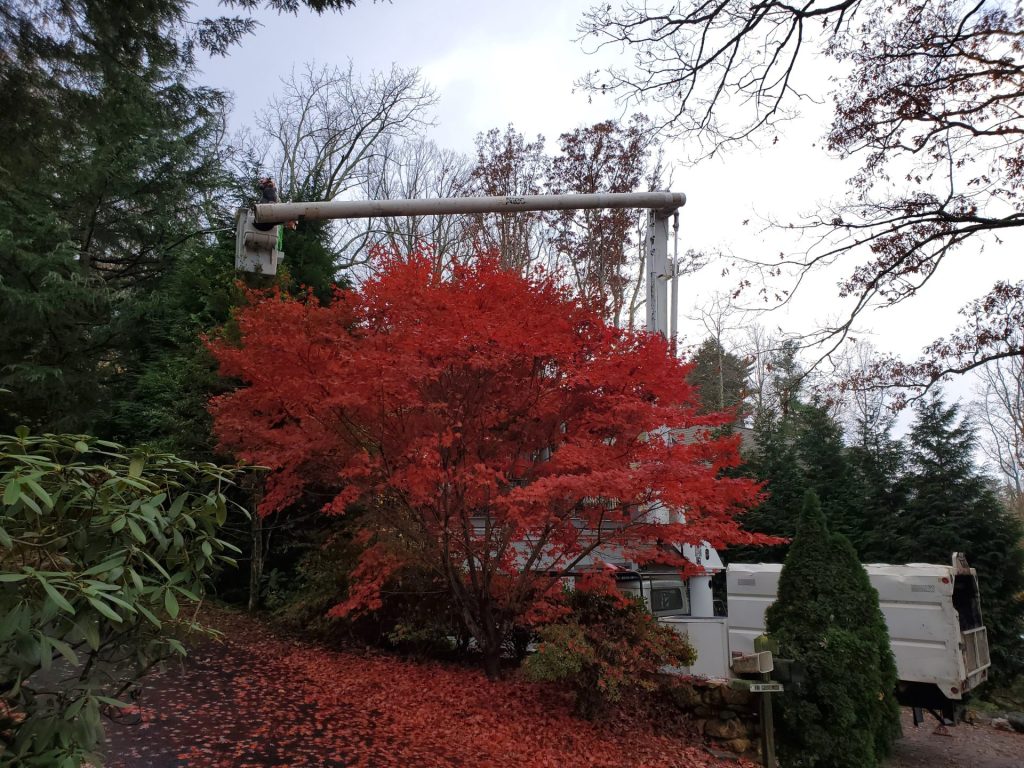Storm damage tree prevention has become critical as severe weather events increase nationwide. Professional tree storm preparation techniques following ANSI A300 standards can reduce your tree’s failure risk by up to 90% while potentially saving thousands in property damage, insurance deductibles, and emergency tree removal costs. With climate change driving more frequent severe weather events, proactive tree care has shifted from luxury to necessity for homeowners.
Understanding when and how to storm-proof trees isn’t just about preventing damage; it’s about protecting your property investment while maintaining the 3-15% value that mature trees add to your home. The average storm damage claim ranges from $4,757 for ice damage to $24,000 for tornado damage, while preventive storm-proofing typically costs $300-$700 per tree. This is delivering an ROI of over 2,000% if it prevents just one major incident.
Professional Tree Storm Damage Prevention Techniques
Crown thinning represents the most effective storm damage tree prevention technique, reducing wind resistance while maintaining tree health. Professionals following ANSI A300 Part 1 (Pruning) standards selectively remove 25-30% of foliage throughout the crown, focusing on secondary branches while preserving the tree’s natural architecture. This technique allows natural flexing during wind events while preventing the dangerous “sail effect” that leads to blow-over.
Professional tree pruning for storms extends beyond simple branch removal. Crown reduction systematically lowers tree height and spread by cutting back to lateral branches at least one-third the diameter of the removed section. This technique reduces the tree’s center of gravity and mechanical stress while maintaining structural integrity; something impossible to achieve with topping or other amateur techniques.
Tree Cabling and Bracing Systems
Tree cabling and bracing provide crucial support for storm resistant trees with structural weaknesses. Static cable systems using high-strength galvanized steel (rated for 20,000+ pounds) connect weak branch unions in the upper two-thirds of the crown. Dynamic systems use synthetic ropes that allow natural tree movement while providing support, reducing girdling risk and extending system life to 20-40 years.
Proper installation matters critically. Cables must be placed at precise angles with proper hardware such as J-lags, eyebolts, and thimbles to distribute loads effectively. Improper installation can create failure points worse than the original problem, which is why these systems require professionals trained in ANSI A300 Part 3 (Support Systems) standards.
Tree Risk Assessment and Root Zone Management
Root zone management often gets overlooked but proves crucial for tree storm preparation. Professionals understand that heart-root systems provide the most efficient wind resistance, combining lateral, oblique, and vertical roots for optimal anchorage. They use specialized air tools to expose root collars buried under soil or mulch, improving both tree health and stability.
Professional tree risk assessment identifies vulnerable trees before storms hit. This systematic evaluation examines tree structure, health, and environmental factors that contribute to failure risk during severe weather events.
Why Trees Fail During Storms and Emergency Tree Removal Costs
Tree failure during storms follows predictable patterns that professionals trained in ANSI A300 standards can identify and address. Blow-over accounts for 35% of all storm-related tree failures, typically occurring when saturated soils reduce root anchorage by 300%. Stem failure represents another 25% of failures, usually at points where decay, cracks, or weak unions create structural vulnerabilities.
Ice storms prove most destructive to tree structure, with just half an inch of ice accumulation causing major structural failure in vulnerable species. The physics are unforgiving: ice can increase branch weight by 30 times, while wind speeds over 40 mph create critical stress points that cause crown twist and branch failure.
Emergency Tree Removal vs. Prevention Costs
The financial impact hits homeowners hard. Emergency tree removal during storms costs $150-$250 per hour, with typical removal ranging from $200-$2,000 per tree. When trees damage homes, repair costs average $1,500-$5,000, with roof replacements reaching $46,000 in worst-case scenarios. These costs accumulate quickly, making prevention the smart financial choice.
Tree removal cost comparison shows prevention wins decisively. Professional storm-proofing costs $300-$700 per tree compared to emergency removal costs that can exceed $2,000 per tree, plus property damage repairs.
Storm Resistant Trees: Which Species Need Immediate Attention
Certain species face dramatically higher storm vulnerability, making professional tree care crucial. Boxelder, silver maple, and Bradford pear top the high-risk list, with their weak branch attachments and brittle wood creating multiple failure points. Bradford pears, in particular, suffer from included bark that creates inherent structural weakness.
Multiple visual indicators signal immediate professional tree care needs. Dead branches larger than 4 inches in diameter, deep cracks in trunks, and trees leaning more than 10 degrees from vertical all require immediate attention. “Widow makers” which arebroken branches hanging in the canopy that pose immediate safety hazards and must be removed professionally.
Storm Resistant Trees vs. Vulnerable Species
Species-specific vulnerabilities follow predictable patterns. Deciduous trees show a 4.8% severe damage rate during storms compared to minimal conifer damage, largely due to their broader crowns and different growth patterns. Evergreen species with excurrent (conical) growth patterns naturally shed ice and wind loads more effectively than broad-crowned deciduous species.
Tree age significantly affects vulnerability. Trees under 15 years respond well to structural pruning and show higher survival rates when properly maintained. Mature trees (15-50 years) reach peak storm resistance when healthy, but trees over 50 years face increased vulnerability from accumulated defects and internal decay.
Visual warning signs homeowners can identify include V-shaped branch attachments (weak) versus U-shaped attachments (strong), mushroom growth at the tree base indicating root decay, and lopsided crowns with more than 70% of branches on one side. Internal decay and structural defects often remain invisible to untrained eyes, making professional assessment crucial for high-value trees or those near buildings.
Hurricane Tree Preparation and Winter Storm Damage Prevention
Regional storm patterns demand tailored tree storm preparation approaches. Hurricane-prone areas require pre-season preparation between February and May, focusing on canopy thinning and support system installation. Working during hurricane season (June-November) should be limited to emergency situations only, as stressed trees heal poorly and emergency services become scarce.
Tornado-prone regions face different challenges, with unpredictable timing requiring year-round preparedness. Areas prone to severe thunderstorms benefit from late winter to early spring preparation (February-April), emphasizing crown reduction and structural pruning before peak storm season.
Winter Storm Damage Prevention Strategies
Winter storm damage prevention requires fall timing in regions experiencing ice storms, with major work completed between November and February during dormancy. Ice storm preparation emphasizes selective pruning to prevent ice loading, removal of co-dominant stems, and crown thinning to reduce weight accumulation.
Species-specific timing becomes crucial for hurricane tree preparation—maple and birch require careful timing to avoid sap bleeding, while oaks need late summer pruning to prevent oak wilt. Climate change is shifting traditional timing windows, requiring professionals to use regional climate data and species-specific phenology to optimize timing recommendations.
Professional Tree Care Investment Analysis
Professional tree care costs prove remarkably cost-effective when compared to storm damage repair expenses. Tree cabling runs $150-$450 per tree with systems lasting 20-40 years, while structural pruning averages $315-$700 depending on tree size and complexity. Professional inspections cost $100-$250 for basic assessments or $150-$450 for detailed reports; again a fraction of potential damage costs.
Insurance coverage limitations make tree damage prevention especially valuable. Most homeowners policies cap tree removal at $500-$1,000 and only cover trees that damage insured structures. Preventive removal, considered routine maintenance, isn’t covered at all. With 2 out of 3 homeowners underinsured and average storm damage claims reaching $24,000, prevention becomes the primary defense strategy.
Tree Removal Cost vs. Prevention ROI
The ROI calculation favors proactive tree care decisively. Preventive cabling at $300 per tree versus potential damage of $7,000-$24,000 delivers returns of 2,233%-7,900% if it prevents one major storm incident. Even considering the probability of storm damage, the cost-benefit analysis strongly favors professional storm-proofing for valuable trees near structures.
DIY approaches prove both dangerous and ineffective. Statistics show 80% of tree-related injuries involve homeowners attempting DIY work, with 100 people dying annually from falling trees. Professional chainsaw and safety equipment costs exceed $1,000, while the expertise required for proper pruning cuts and risk assessment takes years to develop.
Advanced Tree Care Technology and Innovation
Drone technology is revolutionizing tree risk assessment, enabling detailed inspections of tall trees and hazardous areas without putting workers at risk. AI and machine learning systems now analyze tree health data, predict maintenance needs, and assess risk factors with unprecedented accuracy.
Advanced tree cabling systems have evolved significantly from simple static steel cables. Dynamic systems using synthetic materials allow natural tree movement while providing support, reducing stress and extending system life. Smart hardware incorporates GPS tracking and condition monitoring, enabling predictive maintenance schedules.
Battery-powered equipment now matches gas performance while reducing emissions and noise pollution. Boom-mounted grapple saws keep operators on the ground and away from danger zones, while track-mounted forestry units provide working heights of 60-75 feet with improved mobility and stability.
Storm-Proof Trees: Making the Smart Investment
Professional tree storm preparation represents one of the highest-return investments homeowners can make, particularly given insurance limitations and the escalating frequency of severe weather events. The combination of ANSI A300 standards, proven techniques, specialized equipment, and professional expertise creates protection that DIY approaches simply cannot match.
The decision framework is straightforward: trees near structures, power lines, or high-traffic areas require professional assessment and storm-proofing. Trees showing structural defects, species-specific vulnerabilities, or age-related concerns need immediate professional attention. The cost of prevention consistently proves far less than the cost of damage repair, emergency removal, and insurance deductibles.
Proper storm damage tree prevention requires understanding regional climate patterns and species-specific vulnerabilities. Professional tree care providers trained in ANSI A300 standards understand these regional differences and can tailor techniques accordingly. They follow standardized practices that guarantee work meets industry standards and provides legal protection in court systems.
For comprehensive professional tree care services that follow ANSI A300 standards, homeowners can access expert storm preparation, risk assessment, and preventive maintenance. These services provide the expertise needed to protect valuable trees and property investments.
Frequently Asked Questions About Tree Storm Preparation
Q: When is the best time for tree storm preparation? A: The optimal timing depends on your region’s storm patterns. Generally, late fall through early spring (November-March) works best for major pruning and cabling work when trees are dormant.
Q: How much does professional tree storm preparation cost? A: Professional storm-proofing typically costs $300-$700 per tree, including assessment, pruning, and support systems. This investment can prevent thousands in damage and emergency removal costs.
Q: What makes a tree storm resistant? A: Storm resistant trees have strong branch attachments, balanced crowns, healthy root systems, and species characteristics that handle wind and ice loads effectively. Professional assessment identifies and addresses vulnerabilities.
Q: Can homeowners do their own tree storm preparation? A: Basic maintenance like removing small dead branches is possible, but professional work is recommended for trees over 15 feet tall, near structures, or requiring specialized equipment. Safety and effectiveness make professional service worthwhile.
Q: How often should trees be inspected for storm damage risk? A: Annual inspections work for most trees, with bi-annual or tri-annual inspections recommended for older trees (50+ years) or those with previous structural issues.
Q: What’s the difference between emergency tree removal and preventive care? A: Emergency tree removal costs $150-$250 per hour and addresses immediate hazards, while preventive care costs $300-$700 per tree and prevents emergencies from occurring.
The window for action is narrowing as climate change drives more frequent and severe weather events. Proactive homeowners who invest in professional tree storm preparation now will enjoy decades of protection while avoiding the emergency costs and availability issues that follow major storm events. The question isn’t whether to storm-proof your trees; it’s whether to do it professionally following ANSI A300 standards or face the consequences of inadequate preparation.



